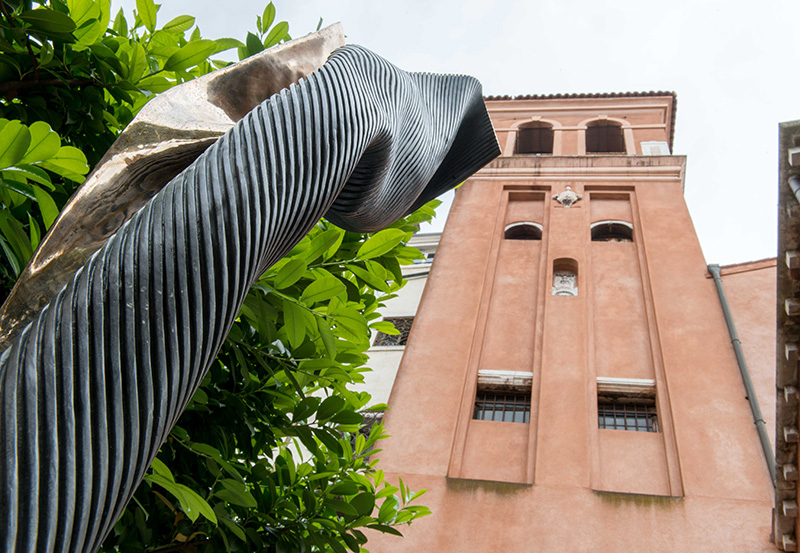INTERVIEW: Andrew Rogers
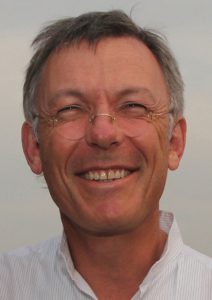 Andrew Rogers is an Australian Sculptor best known for his monumental Land Art project “Rhythms of Life” that began in 1998 and currently consists of 51 massive earth drawings made with stones. These structures are located across all over the world in 13 countries, ranging from Iceland and India to the United States. The locations vary from sea level to altitudes of more than two miles. Rogers also makes open-form abstract sculptures that regularly appear in public spaces such as outdoor plazas. By the occasion of his participation at the collateral exhibition “PERSONAL STRUCTURES-open borders” at the Palazzo Mora in the context of the 57th Venice Biennale, his work complements the ideas expressed by Christine Macel, 2017 Director of the Venice Biennale, in her curatorial statement, that: “In a world full of conflicts and jolts, in which humanism is being seriously jeopardized, art is the most precious part of the human being. It is the ideal place for reflection, individual expression, freedom, and fundamental questions…more than ever, the role, the voice and the responsibility of the artist are crucial in the framework of contemporary debates”, we are discussing with the artist why he presents his series of sculptures “We are” (8 large bronze and stainless steel sculptures), instead of creating an in-situ Land Art project in Venice.
Andrew Rogers is an Australian Sculptor best known for his monumental Land Art project “Rhythms of Life” that began in 1998 and currently consists of 51 massive earth drawings made with stones. These structures are located across all over the world in 13 countries, ranging from Iceland and India to the United States. The locations vary from sea level to altitudes of more than two miles. Rogers also makes open-form abstract sculptures that regularly appear in public spaces such as outdoor plazas. By the occasion of his participation at the collateral exhibition “PERSONAL STRUCTURES-open borders” at the Palazzo Mora in the context of the 57th Venice Biennale, his work complements the ideas expressed by Christine Macel, 2017 Director of the Venice Biennale, in her curatorial statement, that: “In a world full of conflicts and jolts, in which humanism is being seriously jeopardized, art is the most precious part of the human being. It is the ideal place for reflection, individual expression, freedom, and fundamental questions…more than ever, the role, the voice and the responsibility of the artist are crucial in the framework of contemporary debates”, we are discussing with the artist why he presents his series of sculptures “We are” (8 large bronze and stainless steel sculptures), instead of creating an in-situ Land Art project in Venice.
By Dimitris Lempesis
Photo: Andrew Rogers Archive
Mr. Rogers you are one of the first contemporary Land Artist to create so many works outside of the United States and Europe. Your project “Rhythms of Life” since 1999, integrates 51 Land Art sculptures in 16 countries, across all seven continents. Are your projects in direct relationship with the place and the history?
“Rhythms of Life” is a connected series of drawings on the earth visible from space. The structures refer to the physical building blocks of history and civilisation. The series is about creating history and creating linkages to the heritage of the people who help to create the structure. The symbols created are selected in consultation with local elders, authorities and historians.
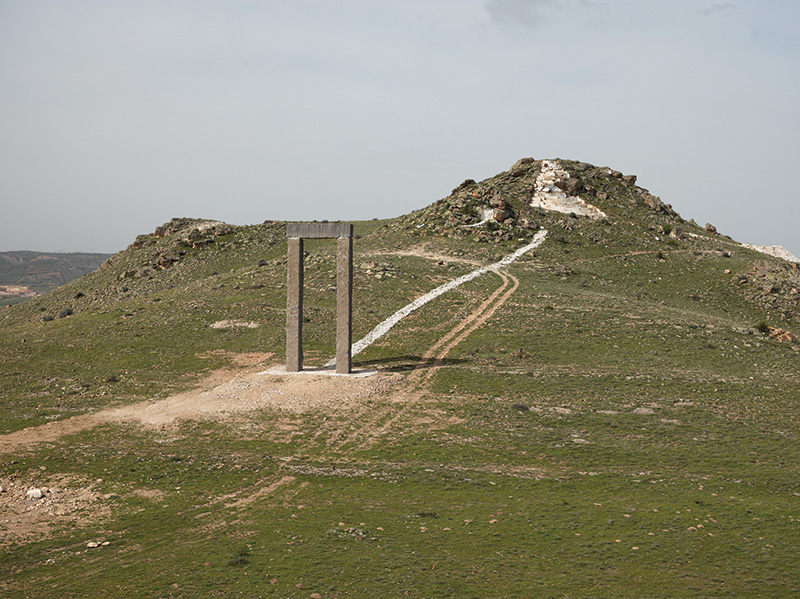
In an era in which technology has inundated everything, even art, you remain loyal to Land Art and many of your works explore a core, primal relationship with nature. To what degree do you use technology in your work?
The early projects involved days of painstaking mapping, manually outlining the geoglyph on the land with a tape measure to triangulate each point in three directions for accuracy. Now, thanks to digital devices, we are able to map the geoglyphs in detail with a GPS during the first days on the site. This has reduced the mapping process from seven days to two. One of the goals of this unprecedented global undertaking was to form a connected set of drawings on the earth visible from space. To achieve this, satellites were used to capture these contemporary sculptured structures around the Earth. The use of these satellites in this way was a first. Earth Observation sensors were utilised to acquire high-resolution satellite imagery from altitudes between 310-500 miles above the Earth’s surface.
This project is now visible to all via Google Earth (Link: http://youtu.be/8JE0G6tlP2A) and the Google Cultural Institute Art Project Website. (Link: www.google.com/culturalinstitute/beta/exhibit/jAKCR_yu8dh_Iw )
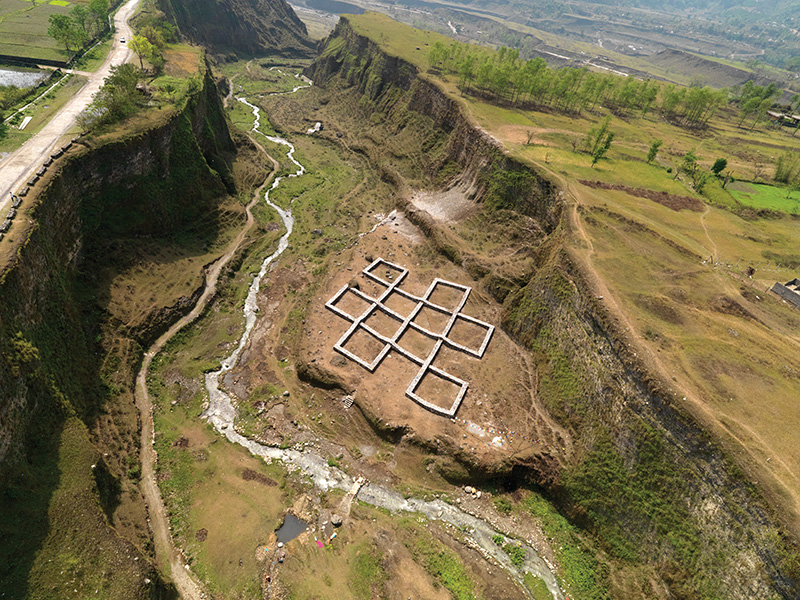
In a period of Global Crisis, how easy is it for an artist to find founding for large scale artworks, in so many distant parts of the Earth?
Political instability and war are not conducive to gathering a thousand people together to create Land Art. As a result, projects in some parts of the world are on hold.
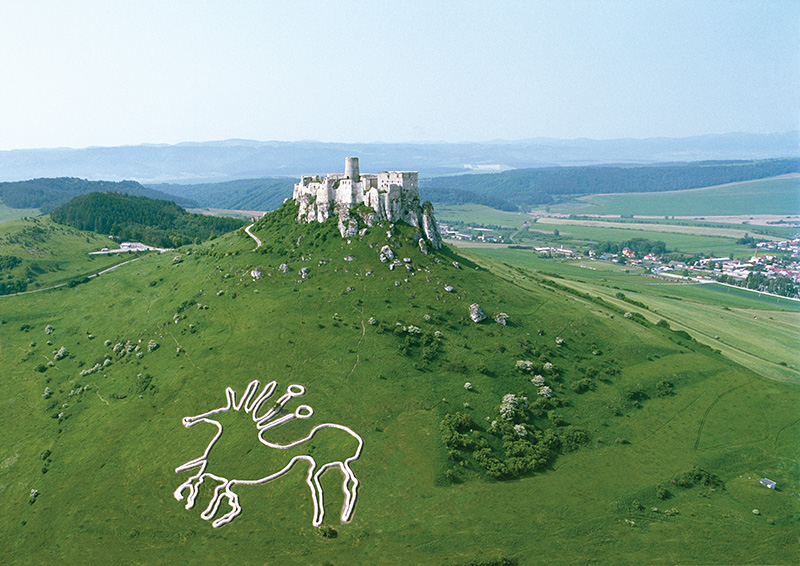
Through Land Art do you want to send an optimistic message about the contamination of nature and the destruction of the planet?
The satellite images reinforce that no matter how large people’s endeavours are, they amount to only a speck in space. Although these structures are strong enough to last over 100 years, they will eventually reintegrate with the landscape, therefore occupying only a moment in time. They are about the importance of the perspective that we are caretakers. We have responsibilities to those around us and those that will follow. We receive the consequences created by our predecessors. In turn we leave a consequence for our descendants. The present will be reflected in the future. In many places I have worked I see the effects of degradation and climate change reinforcing that we need to look after our earth.
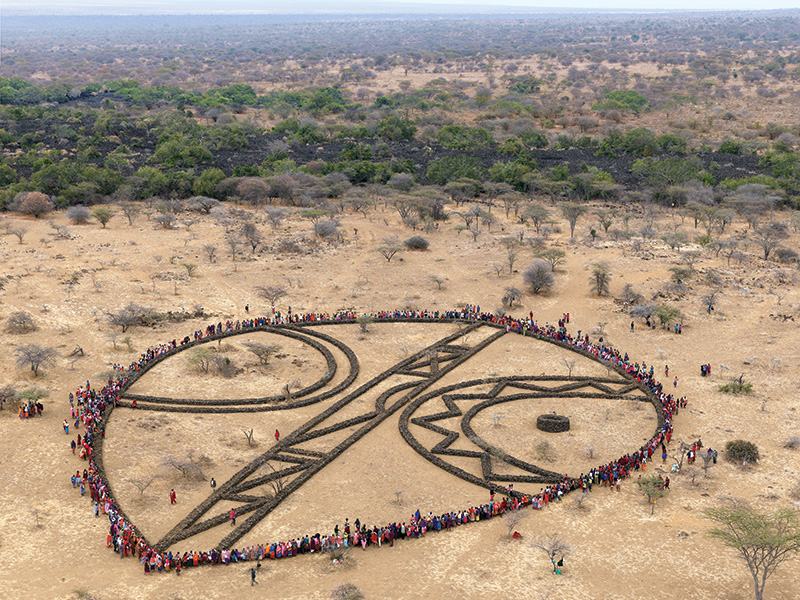
Why did you choose the “Rhythms of Life” series to be experienced in their entirety only from the air, reminding the geoglyphs in the Nazca Desert?
The Rhythms of Life structures are visible when you walk on the ground. The experience of seeing them from the air gives a perspective of scale and the whole relationship to the earth. Although these works are large scale, consisting of thousands of tons of rock and some occupying up to 40,000 square metres, they are really only a speck in space. It is this perspective that I would like people to grasp. No matter how large man’s endeavours they are only small in the history of the world.
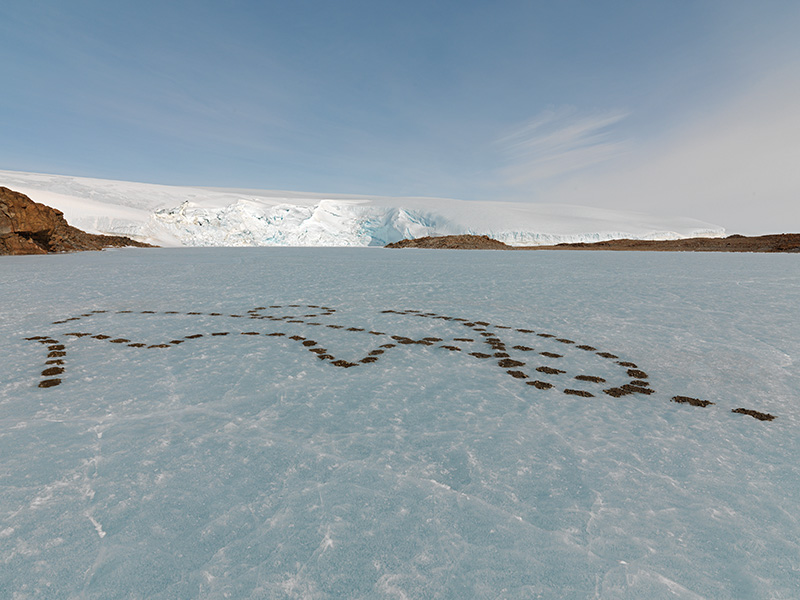
In the exhibition “PERSONAL STRUCTURES – open borders” at Palazzo Mora in Venice, the series of sculptures “We Are” is a further iteration the series “I Am”, also is philosophically related to your ongoing series of geoglyphs titled “Rhythms of Life “, which is their common conceptual axis?
Philosophically the sculptures comprising “We Are” relate to my Land Art and geoglyphs. Both comment on cultural diversity, globalization and shared humanity. Both are about expressing the idea that although we are individuals we are part of the society in which we live. They are both metaphors for the inseparable relationship between singularity and community. Both push boundaries in terms of form and the challenge of achieving a special structure. Both are about the interconnection of humanity throughout time and space. Both should act as a catalyst for a vision of a better world.
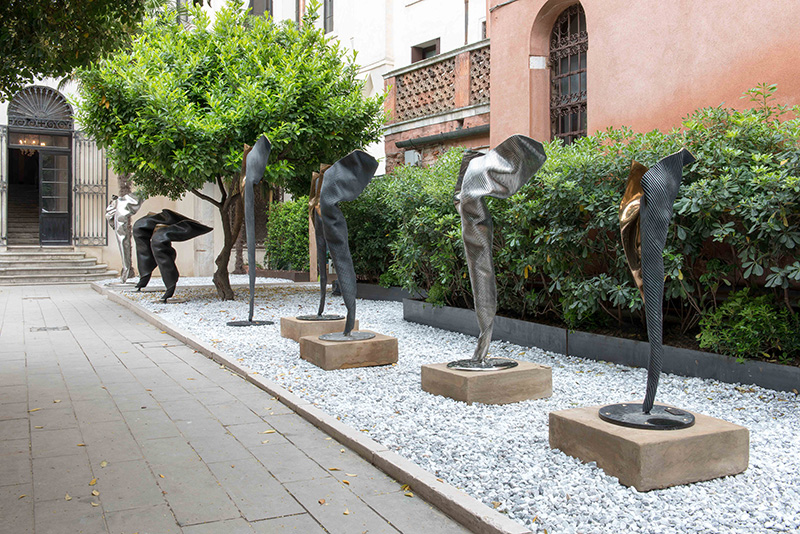
Why did you choose to exhibit a series of large scales sculptures in Venice instead to create a Land Art project?
Exhibiting sculptures and creating Land Art are not mutually exclusive events. My Land Art and sculptural practice within the consideration of elemental materials (stone, metal, etc) and the consideration of the individual’s relationship to the community, the community’s relationship to the world. Considering this work in particular, Venice is a centre of civilization and ancient history. It was and continues to be a place of intersection, where cultures (through trade, empire or tourism) would find connection. It is therefore very appropriate to install a sculpture here that reflects upon the diversity of the individual, as well as the importance this communal dialogue, that reflects on our history and heritage, and also considers that current affairs and actions become future history. Naturally, a Land Art project on an outer island is an enticing prospect that I hope I would be able to explore in the future.
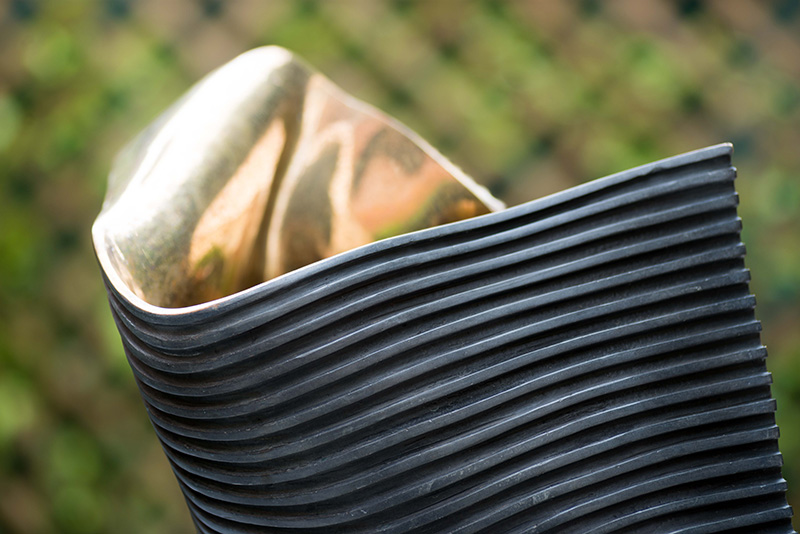
As we know your sculptures are related to human nature and emotions, that is why the titles you are using are relating to the human being; your forms are poetic and organic, is it for you a representation of human himself?
The forms comprising “We Are” are a representation of humans. Like humans they are all similar but different. Like humans they have an organic rippling, pulsating, undulating outer surface which acts as a counterpoint to the delicate, highly-polished interior world of one’s personal thoughts. These forms are full of vibrancy and optimism and about the regeneration of life. The figurative forms remind us that it is the individual that makes our world a place of justice and compassion.
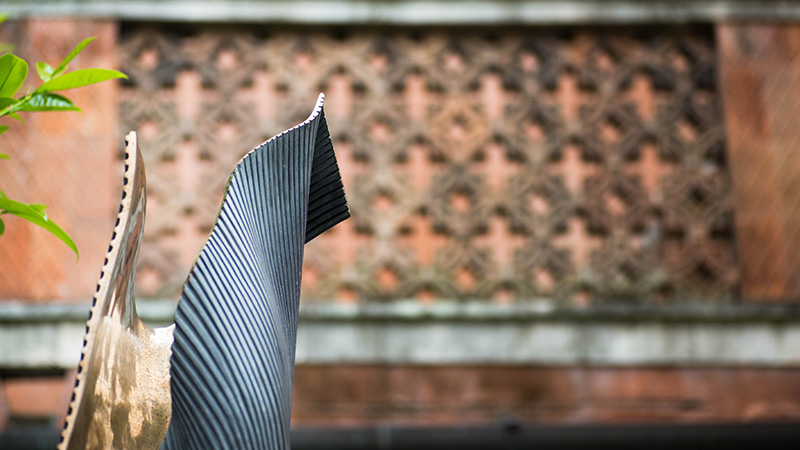
Info: Organizers: Valeria Romagnini, Lucia Pedrana, Sara Danieli, Alesia Varnaeva, Bianca Bonaldi, Elena Volpato, Alessandra Valle, Anaïs Hammoud, Palazzo Bembo, Riva del Carbon, 4793-4785, Palazzo Mora, Strada Nova, 3659 and Giardini Marinaressa, Venice, Duration: 13/5-26/11/17, Days & Hours: Mon & Wed-Sun 10:00-18:00, www.palazzomora.org, www.gaafoundation.org & www.palazzobembo.org
First Publication: www.dreamideamachine.com
© Interview-Dimitris Lempesis
